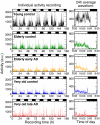Reduction of scale invariance of activity fluctuations with aging and Alzheimer's disease: Involvement of the circadian pacemaker
- PMID: 19202078
- PMCID: PMC2650290
- DOI: 10.1073/pnas.0806087106
Reduction of scale invariance of activity fluctuations with aging and Alzheimer's disease: Involvement of the circadian pacemaker
Abstract
Human motor control systems orchestrate complex scale-invariant patterns of activity over a wide range of time scales (minutes to hours). The neural mechanisms underlying scale-invariance are unknown in humans. In rats, the master circadian pacemaker [suprachiasmatic nucleus (SCN)] is crucially involved in scale-invariant activity fluctuations over multiple time scales from minutes to 24 h. Aging and Alzheimer's disease (AD) are associated with progressive dysfunction of the SCN. Thus, if the SCN is responsible for the scale-invariant activity fluctuations in humans, we predict disturbances of scale-invariant activity fluctuations in elderly humans and even more pronounced disturbances in elderly humans with AD. To test these hypotheses, we studied spontaneous daytime activity patterns in 13 young adults (mean +/- SD: 25.5 +/- 6.1 y); 13 elderly people with early-stage AD (68.5 +/- 6.1 y) matched with 13 elderly controls (68.6 +/- 6.1 y); and 14 very old people with late-stage AD (83.9 +/- 6.7 y) matched with 12 very old controls (80.8 +/- 8.6 y). In young adults, activity exhibited robust scale-invariant correlations across all tested time scales (minutes to 8 h). The scale-invariant correlations at 1.5-8 h declined with age (P = 0.01) and were significantly reduced in the elderly (P = 0.04) and very old controls (P = 0.02). Remarkably, an age-independent AD effect further reduced the scale-invariant correlations at 1.5-8 h (P = 0.04), leading to the greatest reduction of the scale-invariant correlations in very old people with late-stage AD-resembling closely the loss of correlations at large time scales in SCN-lesioned animals. Thus, aging and AD significantly attenuate the scale invariance of activity fluctuations over multiple time scales. This attenuation may reflect functional changes of the SCN.
Conflict of interest statement
The authors declare no conflict of interest.
Figures



Similar articles
-
Decrease in scale invariance of activity fluctuations with aging and in patients with suprasellar tumors.Chronobiol Int. 2018 Mar;35(3):368-377. doi: 10.1080/07420528.2017.1407779. Epub 2017 Nov 28. Chronobiol Int. 2018. PMID: 29182371 Free PMC article.
-
The endogenous circadian pacemaker imparts a scale-invariant pattern of heart rate fluctuations across time scales spanning minutes to 24 hours.J Biol Rhythms. 2008 Jun;23(3):265-73. doi: 10.1177/0748730408316166. J Biol Rhythms. 2008. PMID: 18487418 Free PMC article.
-
Disturbance and strategies for reactivation of the circadian rhythm system in aging and Alzheimer's disease.Sleep Med. 2007 Sep;8(6):623-36. doi: 10.1016/j.sleep.2006.11.010. Epub 2007 Mar 26. Sleep Med. 2007. PMID: 17383938 Review.
-
The suprachiasmatic nucleus functions beyond circadian rhythm generation.Neuroscience. 2007 Nov 9;149(3):508-17. doi: 10.1016/j.neuroscience.2007.03.058. Epub 2007 Oct 24. Neuroscience. 2007. PMID: 17920204 Free PMC article.
-
The human pineal gland and melatonin in aging and Alzheimer's disease.J Pineal Res. 2005 Apr;38(3):145-52. doi: 10.1111/j.1600-079X.2004.00196.x. J Pineal Res. 2005. PMID: 15725334 Review.
Cited by
-
Decrease in scale invariance of activity fluctuations with aging and in patients with suprasellar tumors.Chronobiol Int. 2018 Mar;35(3):368-377. doi: 10.1080/07420528.2017.1407779. Epub 2017 Nov 28. Chronobiol Int. 2018. PMID: 29182371 Free PMC article.
-
Reduced Tolerance to Night Shift in Chronic Shift Workers: Insight From Fractal Regulation.Sleep. 2017 Jul 1;40(7):zsx092. doi: 10.1093/sleep/zsx092. Sleep. 2017. PMID: 28838129 Free PMC article.
-
Advanced analytical methods to assess physical activity behavior using accelerometer time series: A scoping review.Scand J Med Sci Sports. 2022 Jan;32(1):18-44. doi: 10.1111/sms.14085. Epub 2021 Nov 1. Scand J Med Sci Sports. 2022. PMID: 34695249 Free PMC article.
-
Hypertension: Causes and Consequences of Circadian Rhythms in Blood Pressure.Circ Res. 2024 Mar 15;134(6):810-832. doi: 10.1161/CIRCRESAHA.124.323515. Epub 2024 Mar 14. Circ Res. 2024. PMID: 38484034 Free PMC article. Review.
-
Fractal patterns of neural activity exist within the suprachiasmatic nucleus and require extrinsic network interactions.PLoS One. 2012;7(11):e48927. doi: 10.1371/journal.pone.0048927. Epub 2012 Nov 20. PLoS One. 2012. PMID: 23185285 Free PMC article.
References
-
- Swaab DF, Fliers E, Partiman TS. The suprachiasmatic nucleus of the human brain in relation to sex, age and senile dementia. Brain Res. 1985;342:37–44. - PubMed
-
- Zhou JN, Hofman MA, Swaab DF. VIP neurons in the human SCN in relation to sex, age, and Alzheimer's disease. Neurobiol Aging. 1995;16:571–576. - PubMed
-
- Liu RY, et al. Decreased vasopressin gene expression in the biological clock of Alzheimer disease patients with and without depression. J Neuropathol Exp Neurol. 2000;59:314–322. - PubMed
Publication types
MeSH terms
Grants and funding
LinkOut - more resources
Full Text Sources
Medical

